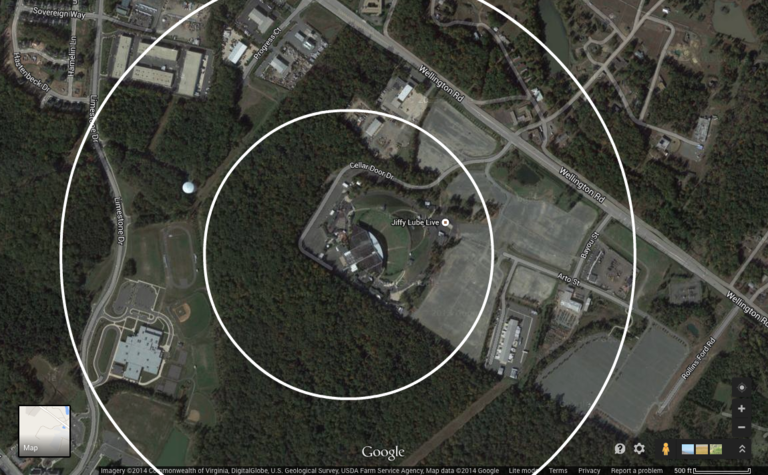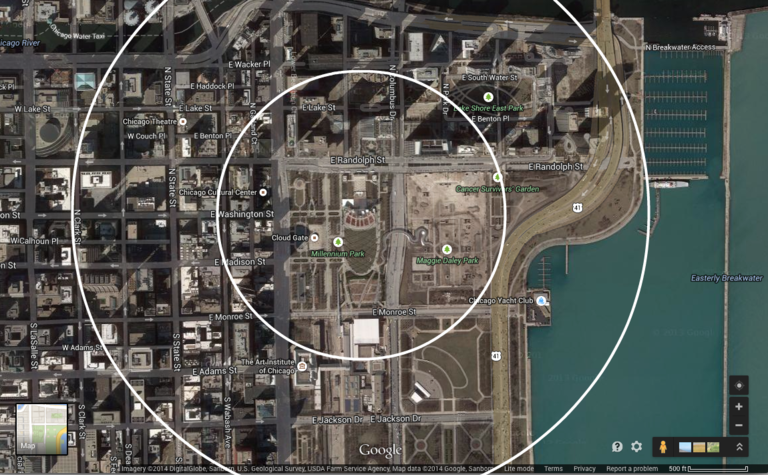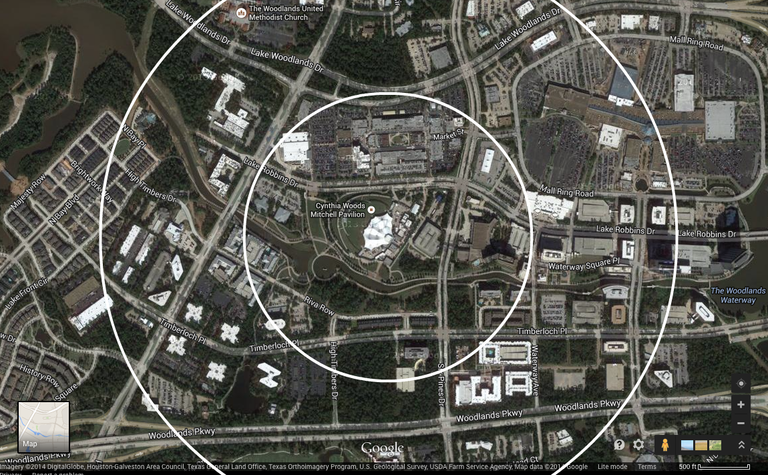I previously discussed parking at Merriweather Post Pavilion. How does Merriweather fare compared to other venues? Do they offer any glimpses of Merriweather’s future with respect to parking? For this post I picked three different venues, each with a Merriweather connection and all of them together showing a wide range of venue parking situations.

Jiffy Lube Live and surroundings, Bristow VA. The circles show areas within a quarter mile and half mile of the venue. Click for high-resolution version.
First is Jiffy Lube Live (formerly Nissan Pavilion) in Prince William County, Virginia. Jiffy Lube Live is notable as Merriweather Post Pavilion’s most serious local competitor for outdoor summer concerts. With a total capacity of 25,000 (10,000 in the pavilion proper, and 15,000 on the lawn) it is significantly larger than Merriweather, and thus tends to attract the very largest shows. As can be seen from the aerial view of Jiffy Lube Live, the venue is located in a primarily rural area, with plenty of space for open-air parking.1
Despite that, Jiffy Lube Live has persistent and at times horrendous problems with parking and traffic, as evidenced by the large number of complaints on Yelp and elsewhere. To quote from the very first reviewer: “The parking lot … is a total and utter nightmare! Every freaking show it takes HOURS to get out.” He went on to note: “Merriweather parking is so much easier!” Part of the problem is that although Jiffy Lube Live is close to I-66 it can be reached only via a two-lane road, and there is apparently only one main entrance and exit to the parking lots. However traffic management seems to play a role as well; one Yelp reviewer vented at length to the venue operators:
I have to say that without a doubt, the exit out of the parking lot was the worst I’ve ever seen at a concert. I’ve been to Merriweather Post and Wolf Trap several times—and your venue wins the prize for the most amateurish traffic and parking lot management in the [DC/Maryland/Virginia area]. It took us 1.5 hours to get out—that was longer than [the] actual set. …
Your “senior” staff abdicated responsibility to a bunch of pimply faced teenagers with no training, who had no idea what they were doing. Worse yet, what few of them there were—all stayed bunched together at the very end of each parking zone. They did NOTHING to help manage traffic flow out of the parking lots. They just stood around, checking their phones and talking to each other.
Ouch. I may be cherry-picking bad reviews to some extent, but overall people apparently have pretty negative feelings about parking, traffic, and other aspects of the Jiffy Lube Live experience; the average Yelp rating for the venue is only two-and-a-half stars (out of five), compared to three-and-a-half stars for Merriweather.2

Jay Pritzker Pavilion in Millennium Park and surroundings, Chicago IL. Circles show areas within a quarter mile and half mile of the pavilion. Click for high-resolution version.
Let’s now turn from a rural setting to a very urban setting, and look at the Jay Pritzker Pavilion in Millennium Park in Chicago. The Pritzker Pavilion has two Merriweather connections: First, like Merriweather it was designed by Frank Gehry, although unlike Columbia Chicago got the benefit of the mature Gehry style.3 Second, the Pritzker Pavilion and the surrounding Millennium Park occupy roughly the same land area as Merriweather Post Pavilion and Symphony Woods, and the Inner Arbor Trust has used Millennium Park as an example of the sort of structures and activities that could be fitted in the combined “Merriweather Park” footprint.
As can be seen from the aerial view of the Jay Pritzker Pavilion, there is essentially no open-air parking available anywhere near the pavilion and the surrounding park. However there is a complex of underground parking garages providing over 9,000 spaces in total, most of them within a quarter mile of the pavilion, and there are also nearby rail and bus transit stops. The Pritzker Pavilion is wildly popular (rated at four and a half stars on Yelp), and in reading nearly a hundred reviews I found only one complaint about parking—and that seemed to be as much about the cost as about the availability. (Note also that I found many reviewers commenting on how clean the bathrooms were.)

Cynthia Woods Mitchell Pavilion and surroundings, The Woodlands, Houston TX. Circles show areas within a quarter mile and half mile of the venue. Click for high-resolution version.
Unfortunately (or not, depending on your perspective) Columbia is not a major city like Chicago and thus doesn’t have the transit infrastructure to supplement on-site or nearby venue parking. Probably a better comparison is thus to the Cythnia Woods Mitchell Pavilion (also known as the Woodlands Pavilion) in The Woodlands outside of Houston. Like Columbia, The Woodlands is a planned community and is of roughly similar size (just over a hundred thousand residents). (The pavilion itself is named after the wife of George Mitchell, who as the original developer of The Woodlands played a role similar to that of Jim Rouse in Columbia.) As you can see from the aerial view of Cynthia Woods Mitchell Pavilion, like Merriweather the pavilion is located in an exurban location that is heavily car-dependent, with the pavilion itself surrounded by office, residential, and retail developments, including a nearby regional mall. Both pavilions have roughly similar maximum capacities as well, at around 19,000 people (including both pavilion and lawn).4
In fact, the parallels between Merriweather Post Pavilion and the Cynthia Woods Mitchell Pavilion are so close that in 2005 the Citizens Advisory Panel on Merriweather Post Pavilion specifically referenced the Cynthia Woods Mitchell Pavilion as one of the case studies in their final report [PDF]. Of particular interest in this context are comments by Jerry MacDonald, president and CEO of The Cynthia Woods Mitchell Pavilion Center for the Performing Arts, regarding parking:
MacDonald believes that parking is generally not a problem for the pavilion during most concerts, but there are a few major concerts a year, attracting up to 12,000 people, where parking needs are at a premium. MacDonald has agreements with surrounding office buildings to use 5,000 parking spaces and the pavilion has a 932-space garage adjacent to its facility. MacDonald said parking generally fills up in the mall corner nearest the pavilion, but there are many unused spaces on the north side of the facility. He suggested shuttles could be used to distribute parking more evenly.
This sounds like a good guide to the future of parking at Merriweather: leverage parking at nearby office buildings, make use of mall parking when needed, and employ shuttles to more remote parking lots (e.g., on the north side of the Mall in Columbia or at Howard Community College in the case of Merriweather) for the very largest events. The one element not currently present at Merriweather is an on-site parking garage; however the Columbia Association’s original Inner Arbor conceptual plan included exactly such a garage with a capacity of 1,750 cars, almost twice that of the on-site garage at the Cynthia Woods Mitchell Pavilion.
The Cynthia Woods Mitchell Pavilion has been a very successful venue. In addition to hosting popular music concerts it’s the summer home of the Houston Symphony (similar to how Merriweather was to be the summer home of the NSO), and with total annual attendance of over 300,000 in 2010 was second only to the Filene Center at Wolk Trap among outdoor amphitheaters that year. (I couldn’t find recent figures for attendance at Merriweather, but according to the Citizens Advisory Panel report total attendance was about 180,000 in 2004.) Its Yelp ratings (reviewed both as the Cynthia Woods Mitchell Pavilion and the Woodlands Pavilion) are three and a half stars and three stars respectively, similar to that of Merriweather, and like Merriweather most people thought traffic and parking were not problems.
Will Merriweather Post Pavilion continue its own tradition of ease of access and convenient parking once construction in the Crescent area begins in earnest? If I can I’ll be attending the Crescent development presubmission community meeting on March 31, and that’s one of the things I hope to be able to ask about.
Note that the aerial views of Jiffy Lube Live and the other venues discussed in this post are to the same scale, and cover the same area, as the aerial view of Merriweather Post Pavilion in the previous post. ↩︎
The numbers of Yelp reviews for Jiffy Lube Live and Merriweather Post Pavilion are currently 120 and 134 respectively. Google reviews are even more lop-sided: An average of 2.3 out of 5 for Jiffy Lube Live (70 reviewers) and 4.3 out of 5 for Merriweather (43 reviewers). ↩︎
In case you’re wondering what a Frank Gehry-designed structure currently costs, the total price tag for the Jay Pritzker Pavilion was $60 million dollars, of which about $15 million came from a single private donation (from the Pritzker family). By comparison the current Inner Arbor cost estimate is in the neighborhood of $30 million for all proposed features, with the Chrysalis outdoor amphitheater budgeted at $3.5 million dollars. ↩︎
The two pavilions even have their own respective sort-of-hometown indie bands: Animal Collective, originally from Baltimore, famously named an album after Merriweather Post Pavilion, while Arcade Fire singer and songwriter Win Butler and his brother and bandmate William grew up in The Woodlands, an experience that inspired the album The Suburbs. ↩︎